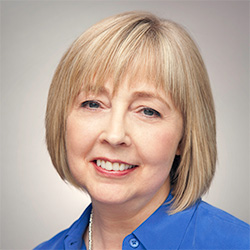From the Senior Editor
The Mystery of the Table

As faculty, staff, and student leaders prepared to take Communion together before a new academic year, Seattle Pacific University Director of Reconciliation Studies Brenda Salter McNeil asked us to think about home, family, and what it means to make room for others “at the table.”
In the New Testament, said Salter McNeil, two formerly different and hostile groups — the Jews and the Gentiles — were joined in a new relationship through the death and resurrection of Jesus Christ. They became a family of believers.
“We come to eat at this table today to declare the mystery of what has been done for us through Jesus,” she continued. “We come to eat at this table today to affirm our common humanity. … Although we don't look alike, and although we don't come from the same backgrounds, and although we don't come from the same places in life socioeconomically or politically, we all have the same basic hungers and we all have the same basic needs, and we come to the foot of the cross to have them met.”
In a divisive world, seeking the restoration of relationships and the welcoming of all people at God's table should be our purpose as Christians, says Salter McNeil in an interview with Response: “That's what I call the vertical and the horizontal truth of the cross, that in Jesus Christ we were reconciled back to God, and we were reconciled back to each other.”
So how can we bring people together across our differences — whatever those differences may be? Response uses the metaphor of “the table” to explore just this question. Faculty and staff members write about seeking “table manners” in everyday life, from online exchanges to family conflicts to the media. Alumni stories convey how food and fellowship can help build strong communities. And Response looks at ways SPU students find themselves at tables of dialogue: building relationships abroad and collaborating in new ways in the classroom.
The commitment Seattle Pacific has made to reconciliation is not only theological, but pedagogical, says Professor of English Kimberly Segall. A faculty member in the reconciliation studies program, she has taken students to South Africa, where they built houses amidst the shanties of urban townships and listened to the stories of former political prisoners; and to Morocco, where they walked the medina quarters in cities and conversed with an imam.
“Knowledge is not neutral,” says Segall. “How do we know things? Why do we learn things? Reconciliation is a reason for seeking information. And it is a critical-thinking framework; it assumes that there are multiple perspectives, not a single viewpoint. But reconciliation is not just a tool to sharpen critical thinking and global relevance. It is a framework of compassion, with the goal of ending conflict and understanding one's neighbor.”
The truth is, we don't always treat people, even family, as we should, and we have excluded others from the table. But, as often as we come to the Communion table, says Salter McNeil, “we are saying to the watching world, which does not believe it's possible to live in harmony and peace, that what we can't do as human beings, God has done through Jesus Christ.”
Jennifer Johnson Gilnett
